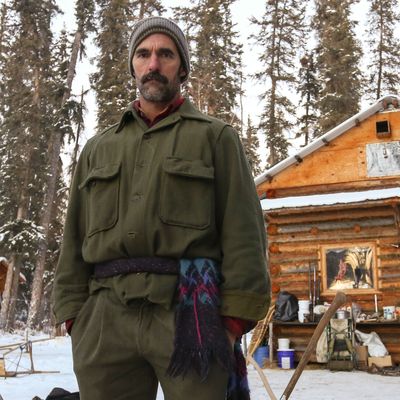
One of the best surprises of the summer has been Animal Planet’s hypnotic documentary series The Last Alaskans. The show follows four families who live in the Arctic National Wildlife Refuge in Alaska — the last families legally allowed to reside there. They live extremely remotely, not even near one another, and the show follows both the extraordinary wilderness conditions and the relative mundanity of their day-to-day routines. The footage is incredible, the subjects hugely compelling. There’s none of that reality-show shtick to the series either that phoniness. Instead, the stories within any given episode are about what compels people to live unusual lives, about what “home” might feel like, and what constitutes isolation. The show’s season finale airs Sunday, and Vulture has an exclusive clip, of Tyler and Ashley Selden trying to find the cabin that Tyler rebuilt over the summer:
Animal Planet has renewed the show for a second season, so we spoke with its executive producer Keith Hoffman to ask some lingering questions about how the distinctive series came to be.
Hoffman says the show had “a lot of different starts,” but things really began to come together a little over a year ago. Heimo Korth, who, along with his wife Edna, is one of the show’s main subjects, is something of a legend, and his cousin wrote a book about him a few years ago.“People have been trying to do shows with Heimo for a long time,” Hoffman says. “There’s a thousand Alaska shows,” Hoffman says. “We really wanted to do something authentic. Once we convinced Heimo of that, it was easier to get everyone else.” That said, not every family who lives in the Refuge participated. “A few are a little more interested now, but we feel we want to go deeper with our four families [for season two],” Hoffman says.
Season one of the show goes pretty deep, though, and part of that is because of how much time the crew spent with each family. Three-member crews were embedded with each family, though they weren’t always covering all four places at once. “Basically, it’s really expensive — you’re not just driving somewhere,” Hoffman explains. While the subjects themselves live in cabins, crew members lived in tents nearby, even in -50 degree weather. “Those cabins can’t be used for commercial use. They would go in once or twice during the year for a communal meal, out of bonding and respect, but [the crew] had to stay outside.”
The show filmed August through January, with a few more weeks of filming later in the winter — and that’s part of why the show feels so languid. “It’s not like we’re going out for a week, so we need something to happen,” Hoffman says. Some of the show’s most striking moments wind up being cinematographic rather than story-driven, thanks to drone cameras capturing the staggering vastness of the environment and GoPro cameras capturing some of the wildlife segments. (There’s an underwater shot of a fish biting a worm off a hook that’s particularly memorable. Hoffman says that was filmed with a GoPro.)
And yet for all the sweeping vistas and poignant monologues, maybe the most riveting moment of the series isn’t on film at all. Bob Harte, a bearded and unassuming guy in his 60s, is wistful and sage on the show but he’s also, for lack of a better term, unbelievably hard-core. He crashed his tiny seaplane and was stranded in the wilderness for four days with no way to contact anyone, and no one was even aware that he’d left. He describes the ordeal on camera — largely unfazed — but the subjects don’t film themselves. Hoffman says it’s a possibility for next season, though. “I think people could forgive if it didn’t look quite as good [as footage shot by crew members] because it’d be real.”
That’s the beauty of the show, the romance of it; I’m not in a position to asses if it is real, but it certainly feels and seems real. We see Ray Lewis, his wife Cindy, and his three almost-adult daughters (the oldest is 21), and the Lewises and Harte speak a lot about how important it is to hunt big game, to kill a moose or a caribou. It’s a point repeated on several episodes. And yet … no moose. No caribou. It just doesn’t happen. We see a lot of trap-setting and fishing, and there’s a lot of candid discussion about the urgency of hunting. The Lewis sisters are very matter-of-fact about it, having grown up with that as a normal part of their lives, but the Seldens — the youngest and least experienced of the families — show more trepidation. There’s a poignant scene of Tyler killing a lynx with a snare trap. It’s not sport and it’s not gratuitous, but it is something you don’t see on television very often. “We’re Animal Planet, so you’re not gonna go to us to watch a hunting show,” Hoffman admits, “but we didn’t want to shy away from it.”
As for next season, Hoffman says to expect mostly more of the same. Maybe we’ll meet more of the subjects’ families (Harte speaks very tenderly of his ex-wife, for example, and the Korths have adult children who don’t live in the Refuge); maybe it’ll cover more of the basic information (like what bathing options are available); maybe we’ll see more of the shopping and planning necessary for a winter in the wilderness. Hoffman confesses that he was a little nervous when thinking about what a whole other season of the show would entail: Was there really more story there? Would things start to feel repetitive? But now that preproduction is gearing up, he’s not worried. “Life changes all the time — any of our lives change from one year to the next, and theirs do, too.”




